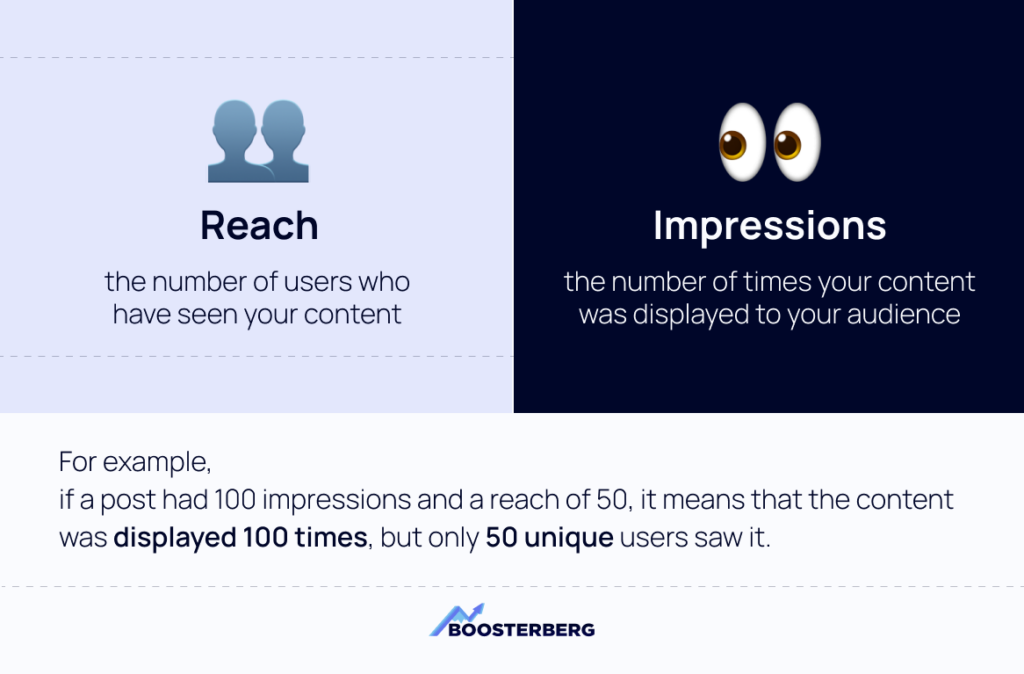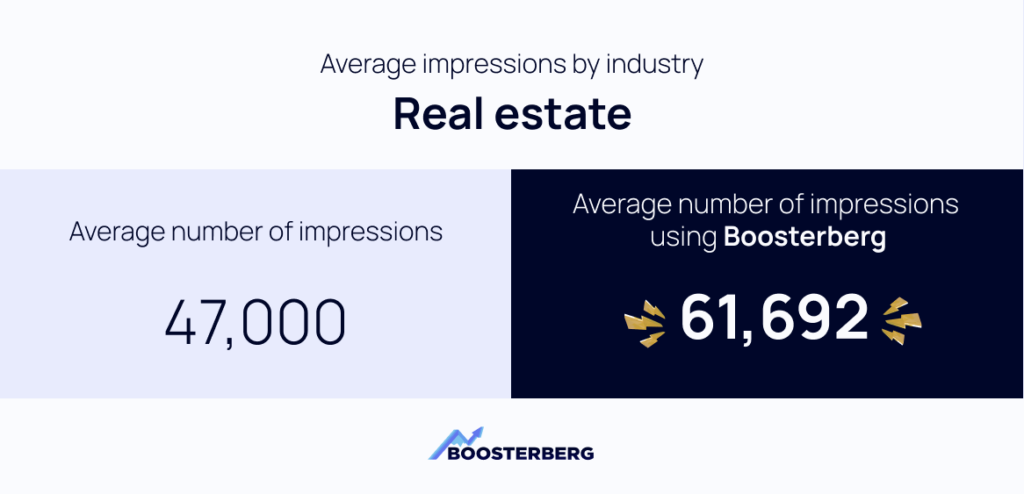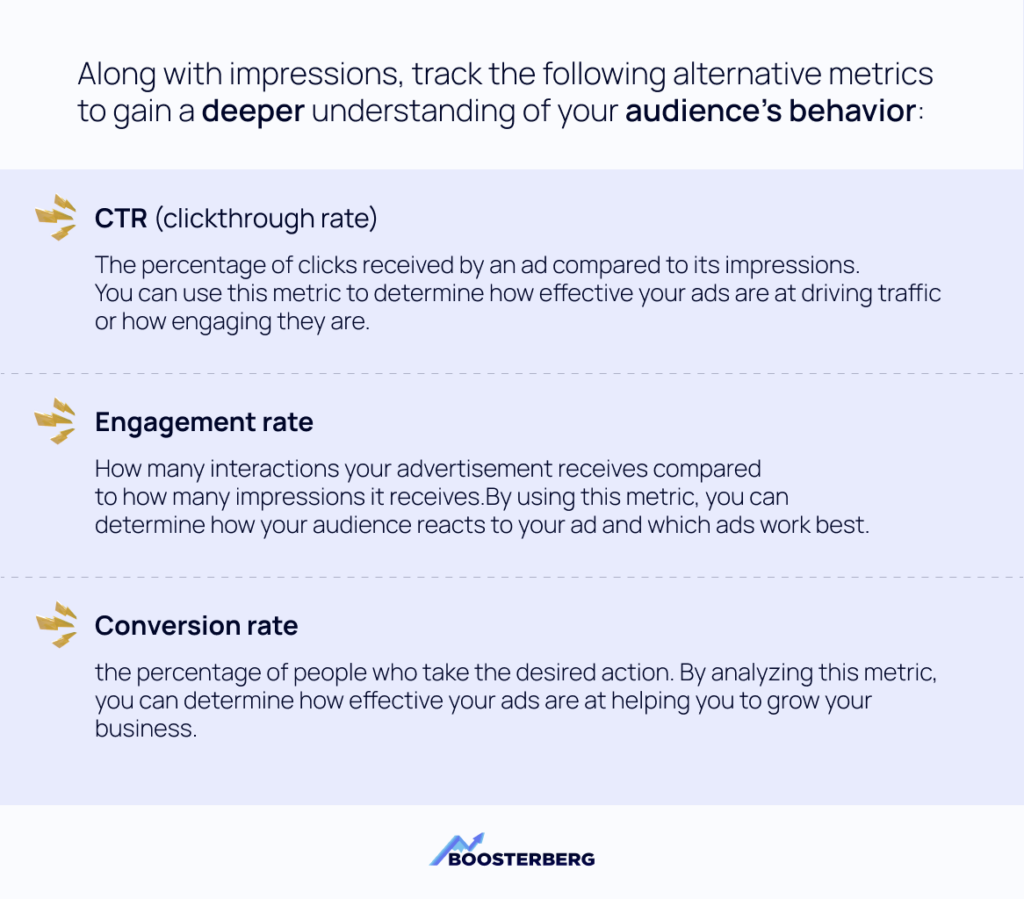Impressions represent the number of times an advertisement or a promoted post is shown to users on a particular digital platform. Whenever you use a website or app with advertising space or ad tags, the code of the site requests information from the publisher’s ad server to decide what advertisement to serve you, and once that ad is shown to you, that is called an impression.
On Facebook, impressions are tracked as follows:
An impression is counted as the number of times an instance of an ad is on screen for the first time. (Example: If an ad is on screen and someone scrolls down, and then scrolls back up to the same ad, that counts as one impression. If an ad is on screen for someone two different times in a day, that counts as two impressions.)
Users can see the same ad in their feed multiple times, and every instance counts as one impression. That means tracking impressions doesn’t tell you how many people have seen your post because one user can see an ad multiple times. Still, impressions are an essential metric in social media advertising.
In this article, we’ll explore the importance of impressions, how they’re calculated, and how to use them to your advantage.
Impressions vs. reach
As we already mentioned, you will not be able to figure out how many people have seen your post based on impressions; instead, you will be able to figure out how many times it has been displayed in people’s feeds. Therefore, tracking reach is the most effective option if you’re looking for the exact number of users that have viewed your ad.
Reach measures the number of people who saw your content, not how many times it was displayed.
For example, if a post had 100 impressions and a reach of 50, it means that the content was displayed 100 times, but only 50 unique users saw it.
Both metrics are essential to evaluate your social media strategy, allowing you to optimize your content and ads.

Why are impressions important?
The number of impressions is useful when you want to quickly identify your most effective and least effective ads. For example, a lower number might indicate that your ads aren’t delivering, and you should optimize them. In another scenario, a high impression but low clickthrough rate may indicate that your ad needs to be revamped.
Additionally, impressions are key to introducing your brand to your audience and increasing your brand awareness. The more of them you get, the more people will be exposed to your brand, increasing your brand’s recognition and familiarity.

When should you optimize for impressions?
Optimizing for impressions means making your ad visible to as many people as possible, regardless of whether they engage with it or take any action.
This can be a good strategy when you want to reach as many people as possible and grow your brand awareness. For example, you can choose this optimization strategy if you are launching a new product and want to ensure that your advertisement is seen by as many people as possible.
In contrast, optimizing solely for impressions may not be the best approach if you want to drive sales or traffic to your website. Other metrics, such as clicks, conversions, or return on ad spend (ROAS), might be more relevant in those cases.
Why you should never focus solely on impressions
When tracking your ads’ reach and visibility, you should consider a few things before focusing solely on impressions.
Impressions tell you how often your ad was seen, but they don’t tell you how engaged your audience was. No matter how many of them your ad receives, it’s probably not very effective if no one clicks on it or takes action.
Moreover, impressions can be easily inflated if ad campaigns are repeatedly shown to the same audience or to non-human traffic, such as bots.

Along with impressions, track the following alternative metrics to gain a deeper understanding of your audience’s behavior:
- CTR (clickthrough rate) – The percentage of clicks an ad receives compared to its impressions. You can use this metric to determine how effective your ads are at driving traffic or how engaging they are.
- Engagement rate – How many interactions your advertisement receives compared to how many impressions it receives. By using this metric, you can determine how your audience reacts to your ad and which ads work best.
- Conversion rate – the percentage of people who take the desired action. By analyzing this metric, you can determine how effective your ads are at helping you to grow your business.
By themselves, impressions aren’t reliable, but when combined with other data, they become an effective metric. They can be used to measure the effectiveness of a campaign or to compare different ad creatives. Using them can also help determine a campaign’s reach or identify the most successful audiences. In turn, this data will allow for more effective long-term strategies and improved returns on investment in future ad campaigns.
